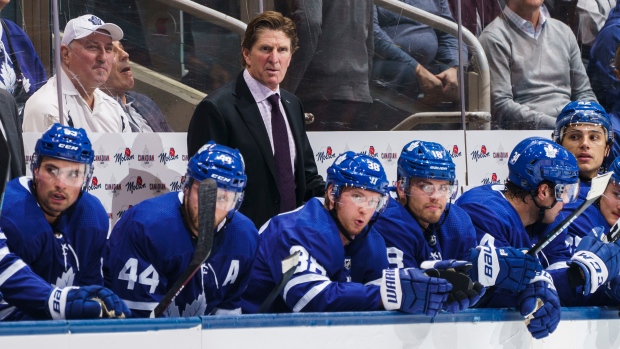Nov 21, 2019
Babcock doomed once Leafs’ offence stopped outscoring defensive issues
Firing a head coach on Nov. 20 may seem early, but Travis Yost explains why the Toronto Maple Leafs weren't simply reacting to a bad month and change of hockey when they dismissed Mike Babcock.
By Travis Yost

At the end of the day, something had to change.
The Toronto Maple Leafs – a team mired in mediocrity since the turn of the calendar year – believed they had built a Stanley Cup-contending roster. A combination of lethally effective attacking units and high-quality goaltending on the back of Frederik Andersen was supposed to drive the team to the top of the standings.
But what the Maple Leafs have delivered, particularly this season, is mediocre performance and mediocre results. The offence has been productive, but not quite productive enough – certainly not enough to offset the defensive issues that mire this lineup on a nightly basis. Andersen has held up in 17 appearances this season, but a rotation of backup goaltenders in Michael Hutchinson and Kasimir Kaskisuo has been a six-game nightmare.
Firing a head coach on Nov. 20 may seem early – especially one as accomplished and established as Mike Babcock, but the Maple Leafs weren’t reacting to a bad month and change of hockey. This organization knew that 23 games of sloppy, inconsistent hockey was a continuation of the second half of last season – a much longer sample of games indicative of an increasingly grim story about the team’s play.
Consider how this team has played throughout the Babcock era. The below plot shows expected goal and actual goal rates since the start of the 2016-17 season, with specific emphasis to the stretch of games in the 2019 calendar year.
The first thing that stands out in the Babcock postmortem is that this team is really no more productive at even strength – the most critical game state, and one that consumes the vast majority of NHL games – now versus where it was during a 2016-17 transition or rebuild year.
In fact, if you segmented this out by year, there’s a compelling argument to be made that Babcock’s transitional lineup was more effective than this year’s purported Stanley Cup contender:
For a few years, the Maple Leafs were generally able to outscore their mistakes. That hasn’t been the case for basically the entire calendar year – you can see their expected goals for in the 2019-20 season have cratered, and the above graph shows that their expected goal collapse started around late January of the prior season.
There will be plenty of debate about how much blame should be apportioned to Babcock versus the front office and Kyle Dubas. The difficult part of doing a post-mortem on how a coach or front office performed is that they are exceptionally reliant on one another. Babcock has, among other things, had to deal with a very makeshift blueline that the front office has struggled to overhaul.
But that same front office provided Toronto with a level of offensive firepower rivalled maybe only by Tampa Bay over the past few seasons. And, for stretches under Babcock, we saw the offence fire as expected – last year’s team, even with the second-half slowdown, finished second in goals scored.
We talked at length about the offensive regression last week. More or less the same personnel from last year’s talented offensive team have all seen their shot volume pushed deep to the perimeter or towards the blueline, where Maple Leafs defenders fired low percentage shot after low percentage shot at the opposition goaltender.
One thing that’s worth remembering – and something I glossed over in last week’s piece – is that any type of structural or systemic changes to improve the defensive state of this team have obviously had zero effect. Expected goals and actual goals against are flat and have been flat for the entire Babcock era.
As for unintended effects? It may have stifled the offence altogether. Remember this year-over-year heat map from the HockeyViz team? Nothing shows the drop-off in offensive performance more – and nothing has impacted their position in the standings more – than what you are seeing below:
There is plenty of blame to go around for Toronto’s slow start – Babcock didn’t get nearly enough out of this roster, and clearly the organization thinks the talent they have compiled should be better than their 9-10-4 start. But with a coaching staff change, attention will now turn to the players and front office.
If new head coach Sheldon Keefe can’t turn things around, Babcock won’t be the only tweak we see from this organization this season.
Data via NaturalStatTrick and Hockey Reference

